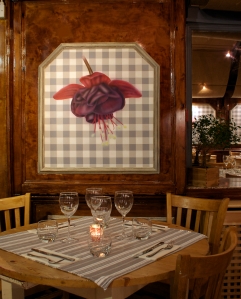As you may have guessed from reading any of my previous posts, I love cheese, so how happy was I to discover that this week was British Cheese Week!!!
Even though I stuffed myself full of kilos of Raclette in Chamonix last week, I thought I would celebrate British Cheese Week in style, by heading down to Daylesford. I picked a neat little selection: Dalesford’s Double Gloucester, Adlestrop and Penyston, some Stinking Bishop and a large Ragstone from Neal’s Yard, all of which we are having for supper later this evening – can’t wait!
Whilst in the shop, I noticed Daylesford was highlighting it’s success at the recently held British Cheese Awards. This year, their Double Gloucester was awarded Gold, Adlestrop was given silver and Penyston received a bronze, so congratulations to Daylesford!
The Times Online covers the awards in more detail.
Looking at the awards website www.TheCheeseWeb.com, I came across the following information on how they organise the cheeses for the judges – I found it particularly fascinating, so I have copied and pasted it below. Enjoy ;-).
…………………………………………………………………………………………………………………………………………..
Unlike wine, animals and books, the character of a cheese can usually be judged by a glance at its cover or rind and an occasional squeeze. From this brief encounter you can learn to judge its texture, strength of flavour, basic character and, with a little practice, its maturity. Using the ‘rind’ method, you can categorise 99% of all cheeses into one of the following and it is also the system we use when organising the cheeses for the judges at the British Cheese Awards.
FRESH CHEESES [No rind]
Examples: Cream Cheese, Feta, Mozzarella
Only 1-15 days old without time to develop a rind and only a subtle ‘lactic’, fermenting fruit flavour with a hint of green pastures. Often wrapped in chestnut leaves, rolled in ash or covered in herbs to give them character. Some are left to drain and dry out, gradually developing a delicate bluish grey mould, a wrinkled rind and a more pronounced flavour and are called Aged Fresh or Natural Rind cheeses and are usually made with goats’ milk].
SOFT WHITE [White Fuzzy Rind]
Examples: Tunworth, Flower Marie, Somerset Brie
The curd retains much of the whey, ensuring the cheese becomes soft and creamy and grows a white mould, Penicillin candidum. Unpasteurised varieties develop a reddish-brown ferment on the rind whereas pasteurised versions are more ‘Persil’ white in appearance. Those made by adding cream to the milk are outrageously luxurious in taste and texture.
SEMI-SOFT [Brown-orange to grey-brown]
Examples: Stinking Bishop, Keltic Gold, Gubbeen, Ardrahan
The moist curd is placed in moulds and lightly pressed to speed up draining. Gradually various moulds develop, these are regularly brushed off building up a thickish rind, protecting the cheese and allowing it to mature. Some are ‘washed’ in brine creating an orange/pink rind with a strong, piquant flavour and aroma.
HARD [Thick, dense rind often waxed, clothbound or oiled]
Examples: Cheddar, Wensleydale, Cheshire
The curd is cut finely, and then heated in vats before the whey is drained off. The curd is cut again or even ‘milled’ and piled on top of itself to remove even more of the whey – this process is called cheddaring. The curd is salted, packed in moulds traditionally lined with cheesecloth and firmly pressed.
BLUE [Gritty, rough, dry or sticky]
Examples: Stilton, Barkham Blue, Shropshire Blue
The blue moulds, P. glaucum or P. Roqueforti are added to the milk but need oxygen to develop their colour. This is achieved by piercing the cheese with rods [normally steel but can be wood or plastic], the blue then grows along the tunnel, cracks and trails between the roughly packed curds.
FLAVOUR ADDED [typically barely formed rind]
Examples: Smoked Cheddar, Wensleydale with Cranberries, Cornish Yarg
There are two types of Flavour Added Cheeses, those where the ingredients are added to the fresh curd so they aged together or the cheese is wrapped with an ingredient for example Cornish Yarg wrapped in nettles. The other type is those called blended or re-formed cheeses. These are made by taking a young cheese, typically cheddar, White Stilton or Wensleydale and
blending it with a variety of flavourings then pressing the cheese into a new shape. Flavours range from smoked to nuts, fruit, spices, herbs even salmon or ham.



 What better choice of food could there be for a Sunday night before a bank holiday, than a curry?
What better choice of food could there be for a Sunday night before a bank holiday, than a curry?